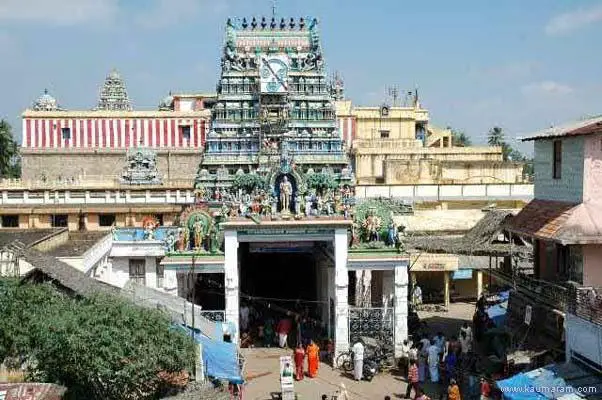The temple, Swamimalai Swaminathaswamy resides the deity “Muruga” as the prime Lord. The Hindu temple is located in Swamimalai, district Thanjavur which is 250 km from Chennai, Tamil Nadu. Among the six abodes of Muruga, this is the second temple dedicated to him. The main shrine is of Muruga, along with his father, Lord Shiva, and mother Parvati, known here as Meenakshi and Sundareswarar, respectively. The prime shrine is located at the top of the hillock at 60 ft, while the other two shrines are located downhills.
The Legendary Tale
The Hindu legend mentions that once Brahma visited Mount Kailash, and there he met Lord Muruga. In a way, Lord Brahma disrespected Muruga, and the child Muruga got angry with Brahma's behavior. Muruga asked Brahma that how he creates living beings. On which Brahma replied, “by using the Vedas.” Muruga then asked Brahma to recite the Vedas, and Brahma started to recite the text starting with the holy word also called Pranav Mantra, “Om”.
Muruga stopped Brahma and asked him to explain “Om.” Brahma couldn't explain the meaning, and then Muruga knocked Brahma's forehead and imprisoned Brahma taking up the role of the creator himself. All Devas were shocked to find Brahma missing, and when they got to know about the actual situation, they all approached Shiva to take care of the matter.
Shiva then went to Muruga, but Muruga refused to release Brahma because he didn't know the meaning of “Om.” On which Shiva asked Muruga the meaning of the same, and Lord Muruga then explained the meaning of Om very beautifully.
This was the time when Shiva was at the student position, and Muruga was the teacher. Hence Shiva gave Muruga the name “Swaminatha Swami,” which means Lord of the Lord or Teacher of the Lord. That is why to represent the positioning of the same mythology, Shiva's shrine is located in the basement while Muruga resides at the top of the hillock.
Architecture
In this temple, the avatar of Lord Muruga is known as Swamimalai and Swaminatha Swami. The temple is built on a KattuMalai, which means an artificial hill. There are three gateway towers and three sections; the one is in the basement, the second one is in the middle, and the third one is at the top of the hillock where the main shrine is situated.
The shrine that is established here of Muruga is about 1.8m tall and remains well adorned with golden crowns, diamond lance, armors, and other adornments. The sixty steps are there to take the devotees to different sections of the temple; each of these steps is named after the sixty Tamil years.
The first section also has the granite shrine of Swaminathaswamy, along with the image of Dakshinamurthy, Durga, and Chandikeswarar. The second is also the largest area in the temple, which houses a marriage hall and the chariot of the temple.
One specialty about the temple is the vehicle or the mount of Lord Muruga. In all other temples, the peacock is considered the mount of Muruga, but here in the temple, it is the white elephant. The white elephant, as being a powerful animal who is not frightened of anything, is built here as the mount of Muruga. This is also common in one temple called Tiruttani Murugan; in all other temples, the only peacock is the mount of Muruga.
The Celebrations
Here the ten days Tiru karthikai festival is considered the most important festival that falls in November-December. A large number of the crowd, that is lacs of devotees, visit the temple and receive the luck to witness the temple in its ultimate glory. Additionally, the ten days Chithirai Brahammotsavam which comes in April-May, is another very significant festival celebrated here.
Other festivals like vaikasi visakam in May-June, Aavani Pavithrotsavam in August-September, ten-day Navaratri in September-October, Aipasi Skanda Sashti in October-November, ten-day Margazhi Tiruvadirai in December-January, Thai Poosam in January-February, and Panguni Valli Kalyanam in March-April are other festivities in the temple.
Some more celebrations are monthly Kruthika star days, monthly Tamil new days, New moon and full moon days, Sashti days, Deepavali and Pongal are also celebrated with great devotion.






